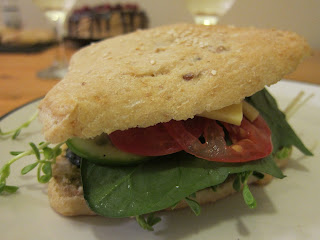One of our main goals on the trip was to see animals. And we did. Despite being winter, the animals were generally out and about. No crocodiles or jellyfish, but we were okay with that.
We had a lot of animal photos. We were going to rank them by cuteness, but we didn't want to be judgmental - who are we to say that a brush turkey is less cute than a sugar glider?
So, in order of size, here are our favorites (excluding spiders and bugs, who may get a separate post). You can judge their respective cuteness yourself.
Most Australian mammals are nocturnal. Our host in the Tablelands had a story for that. Most people, he said, assume that kangaroos are stupid, because they see them in zoos during the day time, when the roos are lounging around, blinking uncomprehendingly. But, our host asked, how smart would we look if some tourist roos woke us up for viewing in the middle of the night?
We had to wait until dark, then, to see some of the marsupials in action. The smallest, but fastest, was the sugar glider. They seem part squirrel, part bat, and part ninja. Crazy fast - they have flaps of skin that allow them to glide between trees. We saw them gliding a couple times, but, like true ninjas, it was too fast to capture. But here they are eating honey off a tree:
Platypus!!
Just outside of Yungaburra was a small creek with a platypus viewing station. We stopped, not expecting to see anything other than a sign like this:

But then, just a few meters downstream, we saw:

Very, very cool. The platypus is now Colin's favorite Australian animal.
Brush Turkey!
As far as we could tell, the least endangered medium-sized animal in the region is the brush turkey. They were everywhere. Naomi caught a nice profile shot:

Sleeping possum in a ball!!
On a short walk outside of Malanda (near Yungaburra, if you're keeping track), we saw a fellow human stopped and looking up. This was the sight:
We're not sure what type of possum this is. But being nocturnal, we assumed it was sleeping... in the form of a cute, furry ball (but with its eyes open).
Along with sugar glider viewing, our place in the Tablelands offered pademelon viewing. Pademelons are a type of rainforest kangaroo. These were 'red-legged' pademelons:

Tree Kangaroo!!??
Remember that weird animal sign from two posts ago? This is what it was telling us to watch out for:
A tree kangaroo. Crazy. These are now Naomi's favorite Australian animal. And no, it is not a monkeybearsheep in a tree. There are several types of tree kangaroos.We believe this is a Lumholtz' tree kangaroo.
About the only thing cuter (not that we're judging) than a tree kangaroo is...
Drooling Tree Kangaroo!!!
What do you expect, for the middle of the night?
Cassowary + Baby Cassowary!!
Last and largest... the most dangerous (but very endangered) bird on the continent:
That fuzzy brown thing is a cassowary chick. We stopped the car to get some pictures. Only later that day did we see signs warning people never to stop their car by a cassowary to get pictures. This one didn't seem too bothered by us, though. We saw so many signs throughout the trip warning us about them, that we felt very lucky to have seen them!

































